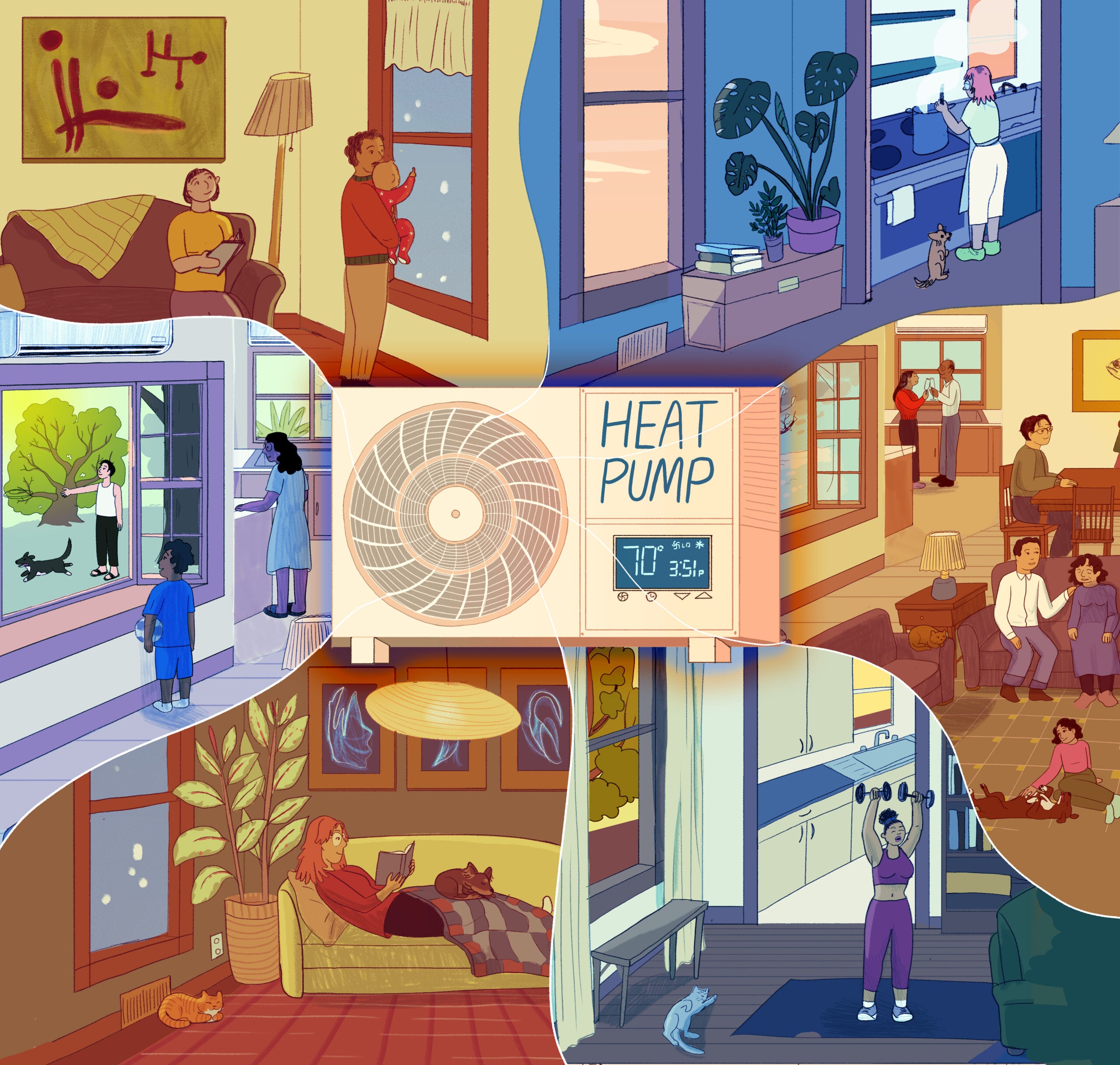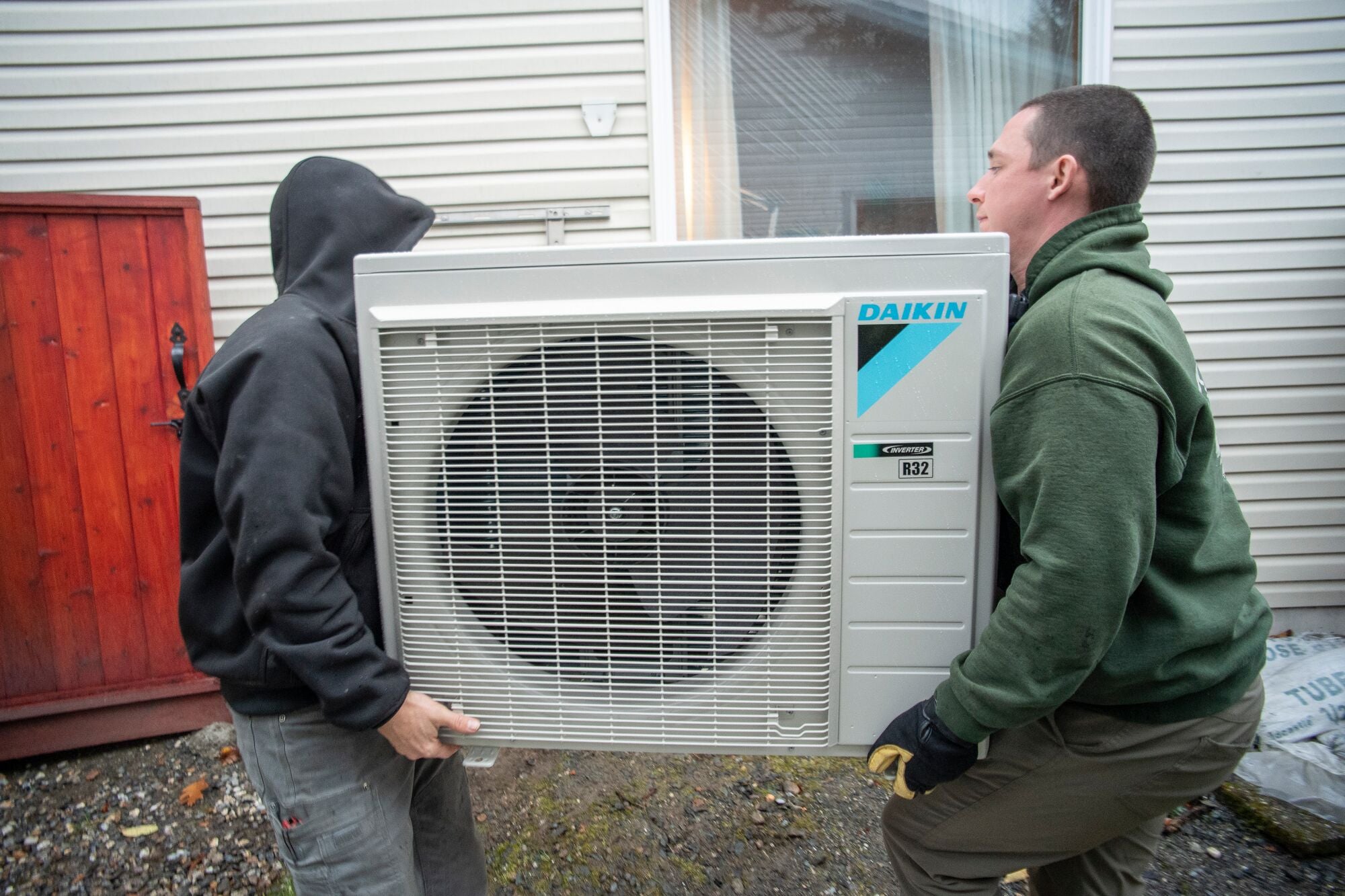The Year-Round Comfort Upgrade that Will Keep Cities Leading on Climate
Why the big swap of air conditioners for heat pumps is a great idea.
From getting on electric buses to moving off plastic bags, California has a long history of cities and counties sparking the momentum for state-level environmental change. When the City of Berkeley moved to make new construction all-electric to cut climate pollution and protect the health and safety of its residents, dozens of cities and counties followed suit. This ripple of city ordinances led to key changes in the statewide building code that now strongly encourage all-electric construction.

Heat pumps can both cool and heat homes. (Lily Padula for Earthjustice)
On the ground in homes and buildings across the state, the change was taking root. By 2023, over 70% of builder requests to Pacific Gas & Electric for electric line extensions were for all-electric buildings. Those numbers will only grow once further advances in the 2025 Building Code are in effect.
While the Trump administration tries to drag us back to darker and more polluted days, policymakers in local government could feel their hands are tied. But local actions to protect our climate are even more important. After all, more than a third of California’s greenhouse gas reduction potential comes from activities over which local governments have authority or influence.

A neighbor uses a wrench stuck into a pipe to turn off a burning gas line at the Eaton Fire on January 8, 2025 in Altadena, California. (David McNew / Getty Images)
This is particularly true for the built environment. Gas appliances like furnaces and water heaters account for 10% of the state’s climate pollution and are a significant source of indoor and outdoor air pollution. After making great strides to limit gas in new buildings, local governments can now turn their attention to shifting existing buildings off polluting fuels with solutions like heat pumps — incredibly efficient appliances that shift ambient heat both into and out of homes to set comfortable temperatures rather than burning dirty fuels.
One of the most impactful and cost-effective strategies to make the shift is to adopt local ordinances to encourage households to replace their central air conditioning units with a heat pump. (Policy wonks refer to this trend as “AC2HP.”)
Why We Should All AC2HP ASAP
Every air conditioning-only installation is a missed opportunity to cut pollution.
Because heat pumps are essentially A/C units with a two-way valve to provide both heating and cooling, single family homes with an existing central A/C unit can simply swap their air conditioning unit out with a heat pump and gain a clean source of heating. (Read about how heat pumps work.)
This makes AC2HP an effective and low-cost climate strategy. Whereas replacing a gas furnace with a heat pump might involve electric upgrades and other costs, the wiring, electric capacity, and space to install a heat pump is already in place when installing a heat pump at the time of A/C replacement.
This single step would go a long way to helping local governments achieve their climate targets and improve air quality: if all central A/C units sold were heat pumps, California could electrify space heating in over half of homes by 2030.
On top of their climate and air quality benefits, heat pumps also create a more comfortable home by maintaining a consistent temperature. Because the average heat pump is more efficient than the average A/C unit, they also bolster grid resilience by reducing electric demand on hot summer days. And by no longer relying on a gas furnace, households don’t have to replace it when it breaks. Households that install a central A/C system now, just to have their furnace burn out a few years down the line, could end up paying for two systems when they could just pay for one.
City Ordinances are Here, Clear, and Ready for Adoption
California is fortunate to have a Codes & Standards program that develops local building energy codes and provides assistance to interested local governments. It recently finalized a model AC2HP Ordinance along with supporting documentation that cities and counties can adopt to implement a AC2HP policy in their jurisdiction. The ordinance requires either the installation of a heat pump or additional efficiency improvements with installation of a new A/C to make up for the lost efficiency savings a heat pump would have provided. Because many people may not be aware they can now get both heating and cooling in a single appliance, AC2HP policies paired with education and outreach can increase contractor and customer awareness and steer the market toward widespread heat pump adoption.

A heat pump goes into a home (Michael Penn for Earthjustice)
Reassuringly, recent legislation pausing advances in state residential buildings codes should not significantly impact AC2HP adoption. The legislation allows local governments to continue to adopt building codes that “align with a general plan approved on or before June 10, 2025, and that permits mixed-fuel residential construction consistent with federal law while also incentivizing all-electric construction as part of an adopted greenhouse gas emissions reduction strategy.” Most local governments can meet these three requirements:
- First, cities and counties need an existing General Plan aligned with AC2HP. The climate, air quality, public health, comfort, and efficiency benefits of an AC2HP policy align with the goals of many general plans. For example, AC2HP adoption furthers the City of Sacramento’s General Plan sustainable building design policy to reduce pollution in public and private development and a number of City of Los Angeles’ Housing Element polices related to efficiency and building standards that further public health. (UC Davis hosts a useful searchable database of general plans.)
- Second, the AC2HP ordinance is designed to avoid potential conflicts with federal law by continuing to permit installation of one-way A/C units and retention of an existing gas furnace.
- Finally, cities and counties need to adopt a greenhouse gas reduction strategy — but timing on that is flexible. Many cities and counties, including Sacramento and Los Angeles, have adopted greenhouse gas reduction strategies. Even if a particular city or county doesn’t already have an adopted climate strategy, the statute does not require a plan adopted prior to June 2025. If this is a potential impediment to AC2HP adoption, a city or county can adopt a greenhouse gas reduction strategy at or before adopting the AC2HP ordinance.

People enjoy a sunny afternoon in a Los Angeles park with a view of the downtown skyline. (Chris Delmas / AFP via Getty Images)
Local Governments Shouldn’t Have to Go It Alone
With Republican’s repeal of $2,000 federal tax credits for heat pump installations at the end of the year (slightly more than the estimated cost difference between standard A/C and heat pump installations), state regulators and energy providers should ensure heat pump incentives continue to cover upfront cost differences between A/C and heat pumps.
For example, the Legislature should allocate revenue from California’s cap-and-trade program to provide stable support for TECH incentives and energy efficiency programs should focus on increasing heat pump adoption instead of dead-end technologies.
While states like Colorado and Massachusetts have phased out incentives for gas appliances, the California Public Utilities Commission has yet to take meaningful action. In addition, some utilities continue to provide rebates for central AC-only systems. Rather than continue to incentivize one way A/Cs and gas appliances, these funds should be used to further increase heat pump affordability.
Bills, Bills, Bills
Electric providers and regulators can also help turbo charge bill savings from heat pump adoption in Californians’ monthly utility bills. For example, CleanPowerSF offers a $50 monthly bill credit for two to three years for customers that switch from gas to heat pump water heating. Similar programs could be offered for AC2HP replacements.
As state regulators look to improve the effectiveness of California’s Climate Credit (bill credits distributed to residential and small business customers from investor-owned utilities’ sale of cap-and-trade allowances) using some of these funds for bill credits to gas customers that switch to clean electric technologies can advance both affordability and climate progress. Establishing heat pump-specific electric rates as Massachusetts recently did is another strategy California can look to to ensure Californians can benefit from key utility bills savings from heat pump adoption.
Heat pumps — they heat, they cool, they curb pollution. These efficient machines to make our homes healthier and more comfortable have a key role to play in our future. For anyone in local government in California who is looking for new policies to improve the lives of their residents in 2025, this is a good place to start.
Earthjustice’s Clean Energy Program uses the power of the law and the strength of partnership to accelerate the transition to 100% clean energy.
